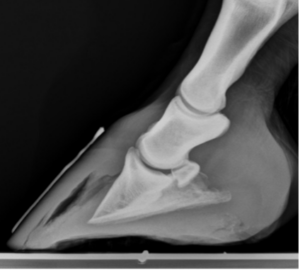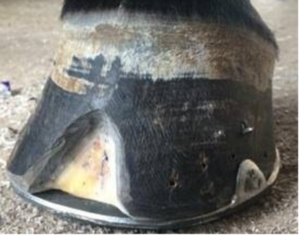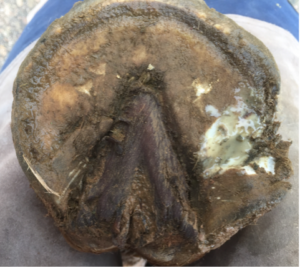As many horse owners know, mid-winter brings snow and other forms of precipitation that often continue through the spring – and that can mean wet and muddy conditions for our equine companions. For horses living outside, these conditions can lead to mud clods and ice balls in the hooves. Prolonged wet conditions can soften feet, making them susceptible to more serious problems, including hoof wall separation (white line disease), thrush, and sole abscesses.
Common winter hoof problems (and how to prevent them)
Thrush
This anaerobic bacterial infection slowly invades the hoof tissue. Thrush is characterized by black, malodorous necrotic, or dead material in the central or collateral sulci of the frog – the grooves adjacent to and in the middle of the triangle-shaped frog. Early stages of thrush affect only superficial tissues and do not cause lameness. But if thrush is not treated promptly and properly, the infection can advance into sensitive tissues and internal structures of the foot, such as the digital cushion, hoof wall, and heel bulb, which can lead to lameness.
The main factors causing thrush are excessive hoof contact with moisture and lack of regular foot care, either of which can occur when snow, rain, and cold temperatures cause some owners to be less diligent about mucking the stall, picking out hooves, or turning out horses for exercise. Although less common, poor hoof conformation can predispose horses to thrush, even when they live in clean, dry conditions.
In most cases, thrush is preventable by maintaining dry footing, clean hooves, and regular turnout or exercise. If you detect signs of thrush, ask your veterinarian about safe treatment options, such as scrubbing the hooves with disinfectant solution and applying thrush treatment to the frog. For horses whose underlying hoof conformation predisposes them to thrush, good management techniques include regular trimming of the foot and frog.
White line disease

White line disease is characterized by progressive hoof wall separation that occurs in the non-pigmented horn of the hoof at the junction between the stratum medium (middle layer of the hoof capsule) and laminar horn. This separation is from a compromise in the white line area of the hoof where anaerobic bacteria (those that don’t like oxygen) or fungi set up shop and lead to disease of the white line and can lead to a nagging lameness. The separation is usually progressive, and it typically involves the toe and quarters of the hoof.
White line disease is an opportunistic disease, meaning the pathogens take advantage of a weakened or compromised hoof wall, such as hoof wall separation. Because white line disease deteriorates portions of the hoof wall, and the hoof wall is further compromised by treatment that requires debridement or resection (removal of the infected hoof wall), secondary problems can occur.

If caught early, white line disease is very manageable. The horse can return to work without a layoff. However, if the fungi and bacteria are allowed to make headway in the hoof wall, treatment can become much more problematic, requiring special shoes, boots, or even a cast, not to mention several months to grow out the hoof.
Movement will also promote blood circulation that can increase hoof growth. If the horse is comfortable moving around and is not in pain, it’s recommended that he be put on some kind of exercise program, turnout, hand walking, or light riding.
One of the best ways to help your horse avoid contracting white line disease is by practicing proper hoof hygiene. Simple steps such as picking your horse’s feet daily can help reduce the risk of contracting this potentially debilitating disease. Extreme weather conditions are thought to increase the hoof’s uptake of these bacteria or fungi. During overly wet or drought conditions, greater care should be taken to ensure proper hoof hygiene.
Snowballs or ice balls
Snowballs are another serious winter issue for horse owners to consider. When snow packs into the hoof and accumulates, your horse might literally end up walking with small mounds of snow under each hoof. Besides being uncomfortable, those snowballs can lead to instability and put your horse at risk for damaging slips and falls. Adding regular pads, anti-snowball pads, or rim pads to your horse’s shoes can help prevent trouble.
Anti-snowball pads, sometimes known as “poppers,” have a hollow, convex dome or “bubble” in the middle. As snow packs in and pushes against the dome, the dome pushes back and “pops” the snow out before it can accumulate. Because the anti-snowball pads cover the entire bottom of the hoof, they can be particularly useful if your horse is flat-footed, lacks vertical depth, or if you have reason to be concerned about sole bruising and abscesses.
While some traditional pads have packing between the pad and the sole, anti-snowball pads should not be packed, because that would interfere with the bubble’s popping ability. If you ride frequently on hard surfaces, such as roadways, realize that the bubble might wear down and lose its popping ability. Unlike anti-snowball pads, tube rim pads, also known as snow rim pads, don’t cover the entire sole. Instead, what looks like a piece of rubber tubing is riveted around the inside edge of the shoe before the shoe is nailed in place. When the horse moves, the tubing flexes, shoving out any snow around the shoes’ edges and preventing accumulation.
Shoes tend to aid snowballing, because snow typically begins to accumulate and pack in at the shoe’s edges. So if your horse goes barefoot, snowballing might be less of an issue. However, if your horse does have a snowball problem – or if you haven’t implemented any anti-snowballing tools then get hit by a sudden storm – you can try an old-timer solution. Grease the bottom of your horse’s hooves with cooking oil, Pam spray, Vaseline, or a similar lubricant. This might prevent snow accumulation for a short period, but will require frequent application.
Sole bruising and abscesses
This time of year, it’s not uncommon for horse owners to report, “Yesterday my horse was perfectly sound, but today he won’t touch one foot to the ground. There’s no apparent injury or sign of a problem in his leg or hoof other than sudden, severe lameness. What could have happened?”

Hoof bruising occurs for many reasons, from thin soles or hoof imbalances that allow abnormal hoof impact to inadvertent horseshoe contact on the sole and riding or walking over rocky terrain. Bruised feet might require changes in the farrier’s approach to trimming and shoeing, and hoof pads or boots might also help protect your horse’s feet. A farrier can detect sole bruising and recommend appropriate therapy.
Hoof abscesses can occur after bruising or from penetrating wounds. The abscesses occur when bacteria get trapped beneath the hoof wall or sole, and then multiply. The bacteria create pus, which builds up and creates focal pressure. This can be quite painful, and a horse is often reluctant to bear any weight on the affected foot, especially the heel. Abscesses remain painful until the pus pockets drain and the pressure is relieved. The abscess often follows the path of least resistance to drain, bursting at the heel bulb, along the coronary band, or through the sole.
Check for a smoldering abscess by pressing your finger on each heel bulb and around the coronary band. Feel for heat in the foot and hoof and for tissue softening; also note your horse’s pain response. If you suspect an abscess, have your veterinarian perform an examination including palpation, hoof testers, and possibly nerve blocks to localize the area of concern. They will then open the abscess to establish drainage. It is rare but these sole abscesses can work their way into vital structures in the foot which can impact therapy and prognosis.
Tips for taking care of your horse’s hooves in the winter
Winter can mean some extra planning and care to keep your horse’s feet in their best condition. But if you manage him properly, you’ll be able to enjoy these fly-free months despite the ice and chill, and can help your horse put his best hoof forward come spring.
Good hoof care includes:
- Frequent/daily hoof cleaning to remove rocks and mud
- Routine farrier care to keep the feet balanced, adequate sole for protection, and snug and uniform sole-wall junction
- Shoes for protection if a horse has thin soles or is prone to bruising
- Be proactive in maintaining soundness by keeping the feet trimmed so they don’t get wall separations that can lead to white line disease and abscesses.